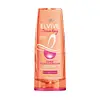What's inside
What's inside
 Key Ingredients
Key Ingredients

 Benefits
Benefits

 Concerns
Concerns

 Ingredients Side-by-side
Ingredients Side-by-side

Water
Skin ConditioningCetearyl Alcohol
EmollientGlycerin
HumectantIsopropyl Myristate
EmollientStearamidopropyl Dimethylamine
EmulsifyingGlycine Soja Oil
EmollientCoco-Caprylate/Caprate
EmollientSodium Hydroxide
BufferingHydroxypropyl Guar Hydroxypropyltrimonium Chloride
Arginine
MaskingHelianthus Annuus Seed Oil
EmollientSalicylic Acid
MaskingLimonene
PerfumingBenzyl Alcohol
PerfumingPanthenol
Skin ConditioningWater
Skin ConditioningCetearyl Alcohol
EmollientDicetyldimonium Chloride
EmulsifyingCetrimonium Chloride
AntimicrobialNiacinamide
SmoothingRicinus Communis Seed Oil
MaskingSodium Benzoate
MaskingHydroxycitronellal
PerfumingHydroxypropyltrimonium Hydrolyzed Wheat Protein
Skin ConditioningHydrolyzed Corn Protein
Skin ConditioningHydrolyzed Soy Protein
HumectantHydrolyzed Wheat Protein
Skin ConditioningPhenoxyethanol
PreservativeSteareth-6
EmulsifyingAcetic Acid
BufferingPEG-100 Stearate
Trideceth-10
CleansingTrideceth-3
EmulsifyingTrisodium Hedta
Chlorhexidine Digluconate
AntimicrobialDimethicone
EmollientLimonene
PerfumingPanthenol
Skin ConditioningBenzyl Salicylate
PerfumingLinalool
PerfumingBenzyl Alcohol
PerfumingIsopropyl Alcohol
SolventAmodimethicone
Alpha-Isomethyl Ionone
PerfumingTartaric Acid
BufferingGeraniol
PerfumingCetyl Esters
EmollientCitronellol
PerfumingCoumarin
PerfumingHexyl Cinnamal
PerfumingParfum
MaskingWater, Cetearyl Alcohol, Dicetyldimonium Chloride, Cetrimonium Chloride, Niacinamide, Ricinus Communis Seed Oil, Sodium Benzoate, Hydroxycitronellal, Hydroxypropyltrimonium Hydrolyzed Wheat Protein, Hydrolyzed Corn Protein, Hydrolyzed Soy Protein, Hydrolyzed Wheat Protein, Phenoxyethanol, Steareth-6, Acetic Acid, PEG-100 Stearate, Trideceth-10, Trideceth-3, Trisodium Hedta, Chlorhexidine Digluconate, Dimethicone, Limonene, Panthenol, Benzyl Salicylate, Linalool, Benzyl Alcohol, Isopropyl Alcohol, Amodimethicone, Alpha-Isomethyl Ionone, Tartaric Acid, Geraniol, Cetyl Esters, Citronellol, Coumarin, Hexyl Cinnamal, Parfum
Ingredients Explained
These ingredients are found in both products.
Ingredients higher up in an ingredient list are typically present in a larger amount.
Benzyl Alcohol is most commonly used as a preservative. It also has a subtle, sweet smell. Small amounts of Benzyl Alcohol is not irritating and safe to use in skincare products. Most Benzyl Alcohol is derived from fruits such as apricots.
Benzyl Alcohol has both antibacterial and antioxidant properties. These properties help lengthen the shelf life of products. Benzyl Alcohol is a solvent and helps dissolve other ingredients. It can also improve the texture and spreadability.
Alcohol comes in many different forms. Different types of alcohol will have different effects on skin. This ingredient is an astringent alcohol.
Using high concentrations of these alcohols are drying on the skin. They may strip away your skin's natural oils and even damage your skin barrier. Astringent alcohols may also irritate skin.
Other types of astringent alcohols include:
According to the National Rosacea Society based in the US, you should be mindful of products with these alcohols in the top half of ingredients.
Any type of sanitizing product will have high amounts of alcohol to help kill bacteria and viruses.
Learn more about Benzyl AlcoholCetearyl alcohol is a mixture of two fatty alcohols: cetyl alcohol and stearyl alcohol. It is mainly used as an emulsifier. Emulsifiers help prevent the separation of oils and products. Due to its composition, it can also be used to thicken a product or help create foam.
Cetearyl alcohol is an emollient. Emollients help soothe and hydrate the skin by trapping moisture.
Studies show Cetearyl alcohol is non-toxic and non-irritating. The FDA allows products labeled "alcohol-free" to have fatty alcohols.
This ingredient is usually derived from plant oils such as palm, vegetable, or coconut oils. There is debate on whether this ingredient will cause acne.
Due to the fatty acid base, this ingredient may not be Malassezia folliculitis safe.
Learn more about Cetearyl AlcoholLimonene is a fragrance that adds scent and taste to a formulation.
It's found in the peel oil of citrus fruits and other plants such as lavender and eucalyptus. The scent of limonene is generally described as "sweet citrus".
Limonene acts as an antioxidant, meaning it helps neutralize free radicals.
When exposed to air, oxidized limonene may sensitize the skin. Because of this, limonene is often avoided by people with sensitive skin.
The term 'fragrance' is not regulated in many countries. In many cases, it is up to the brand to define this term. For instance, many brands choose to label themselves as "fragrance-free" because they are not using synthetic fragrances. However, their products may still contain ingredients such as essential oils that are considered a fragrance.
Learn more about LimonenePanthenol is a common ingredient that helps hydrate and soothe the skin. It is found naturally in our skin and hair.
There are two forms of panthenol: D and L.
D-panthenol is also known as dexpanthenol. Most cosmetics use dexpanthenol or a mixture of D and L-panthenol.
Panthenol is famous due to its ability to go deeper into the skin's layers. Using this ingredient has numerous pros (and no cons):
Like hyaluronic acid, panthenol is a humectant. Humectants are able to bind and hold large amounts of water to keep skin hydrated.
This ingredient works well for wound healing. It works by increasing tissue in the wound and helps close open wounds.
Once oxidized, panthenol converts to pantothenic acid. Panthothenic acid is found in all living cells.
This ingredient is also referred to as pro-vitamin B5.
Learn more about PanthenolWater. It's the most common cosmetic ingredient of all. You'll usually see it at the top of ingredient lists, meaning that it makes up the largest part of the product.
So why is it so popular? Water most often acts as a solvent - this means that it helps dissolve other ingredients into the formulation.
You'll also recognize water as that liquid we all need to stay alive. If you see this, drink a glass of water. Stay hydrated!
Learn more about Water